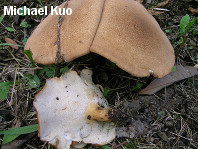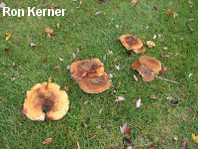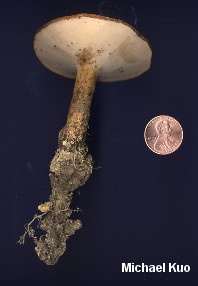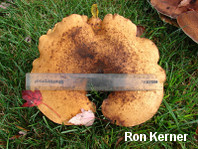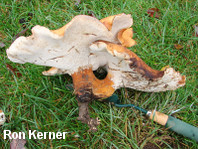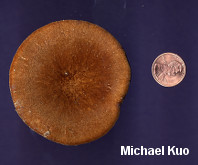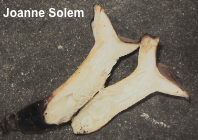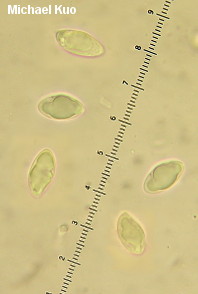| Major Groups > Polypores > Stemmed, Pale-Fleshed > Polyporus radicatus |

|
Polyporus radicatus [ Basidiomycota > Polyporales > Polyporaceae > Polyporus . . . ] by Michael Kuo This Midwestern and eastern polypore appears to be terrestrial, but it actually fruits from buried wood. It is usually solitary, and on casual inspection it looks like anything but a polypore—until you feel its tough consistency and see the underside of the cap, which has a white, Polyporus-ish pore surface. The distinguishing feature of the species is likely to be snapped off by accident when you pick it: it has a long, rooting stem that extends underground. Above ground, the stem is a dirty yellowish color, but the underground section is black. The similar Polyporus melanopus is usually somewhat smaller, and features a rooting stem that becomes black and velvety above ground. Spore sizes for Polyporus radicatus appear to vary, based on the collections featured here; some collections feature spores measuring 11–14 x 6–7 µm, which is what one would expect from the literature, while other collections have substantially smaller spores, measuring 8–10 x 3–4 µm. The two groups do not appear to be separable otherwise. Thanks to Joanne and Robert Solem for documenting, collecting, and preserving Polyporus radicatus for study; their collection is deposited in The Herbarium of Michael Kuo. Description: Ecology: Saprobic on the roots of dead hardwoods (or the dead roots of living hardwoods), growing alone or scattered, terrestrially, in grassy and open areas; causing a white rot; summer through fall; most common in the Mississippi and Ohio valleys, but also appearing in eastern North America. The illustrated and described collections are from Illinois, Indiana, and Maryland. Cap: Generally 3–10 cm but occasionally up to 30+ cm (see illustration); planoconvex to flat or, in old age, shallowly sunken; usually round in outline but sometimes lobed; dry; velvety or with appressed fibrils and small scales; dark yellowish brown to reddish brown; with a tiny (1 mm) sterile margin when young. Pore Surface: Running down the stem; whitish, or in age dingy orangish; not bruising; with 1–3 round to slightly angular pores per mm; tubes shallow, 1–5 mm long. Stem: Central; 3–6 cm long above ground; 0.5–1 cm wide; more or less equal, or slightly enlarged towards base; dry; finely pubescent near the apex; dirty orangish to slightly brownish above ground; with a 4–10 cm, tapering, black "root" extending underground. Flesh: White; soft but very tough; not changing when sliced. Odor and Taste: Odor not distinctive; taste slightly bitter. Spore Print: White. Microscopic Features: Spores 11–14 x 6–7 µm or 8–10 x 3–4 µm (see discussion above); widely subfusiform to subfusiform; smooth; hyaline to faintly yellowish-refractive in KOH; with one large, irregularly shaped oil droplet. Hymenial cystidia not found. Hyphal system dimitic. Clamp connections present. REFERENCES: Schweinitz, 1832. (Saccardo, 1888; Overholts, 1953; Smith, Smith & Weber, 1981; Gilbertson & Ryvarden, 1987; Phillips, 1991/2005; Lincoff, 1992; Horn, Kay & Abel, 1993; Nunez & Ryvarden, 1995; Barron, 1999; Kruger, 2002; Roody, 2003; McNeil, 2006; Kuo & Methven, 2014; Ginns, 2017.) Herb. Kuo 07139401, 06110303, 08040303, 10081807. This site contains no information about the edibility or toxicity of mushrooms. |
© MushroomExpert.Com |
|
Cite this page as: Kuo, M. (2019, November). Polyporus radicatus. Retrieved from the MushroomExpert.Com Web site: http://www.mushroomexpert.com/polyporus_radicatus.html |
